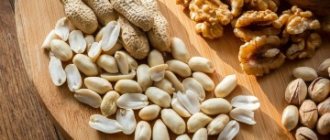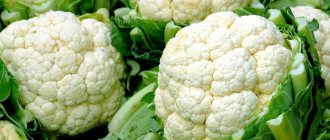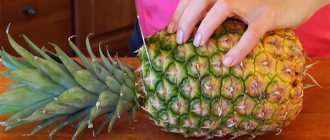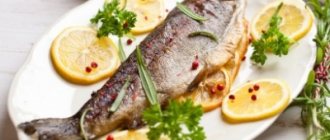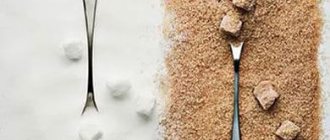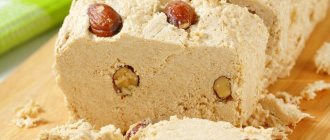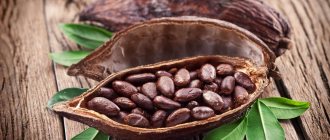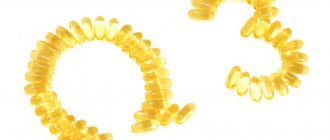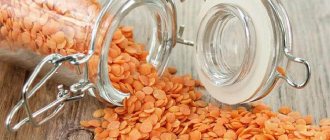Shrimp, squid and other seafood are often perceived as delicacies. This is understandable, because their prices are comparable to the prices for sturgeon caviar. But it should be noted that such products are so filled with substances valuable to humans that they need to be looked at carefully, especially by nursing mothers. But the question naturally arises: is it possible to eat seafood while breastfeeding?
Useful properties of squid
Shellfish has meat that is well digestible, does not create heaviness in the stomach or problems in the intestines, normalizes the production of basic digestive enzymes, and stabilizes metabolic processes. Seafood protein restores muscle tissue.
Squid is called “sea ginseng” for its large amount of useful substances and vitamins, some of which are presented in the table.
| Name | Description |
| Iodine | Needed for normal functioning of the thyroid gland and maintaining hormone balance. |
| Iron | Maintains hemoglobin levels. |
| Selenium | Helps eliminate toxins and waste. It is an immunostimulant and a strong antioxidant. |
| Potassium | Provides health to the heart muscle. |
| Magnesium | Strengthens the nervous system, promotes resistance to stress and depression. |
| Calcium | Maintains the strength of bone tissue and tooth enamel. Provides good condition of hair and skin. |
| Sodium | Provides acid-base balance, regulates metabolism at the cellular level. |
| Copper | Needed to maintain the quality of blood. |
| Fluorine | Essential for the formation of strong bones and strong teeth. |
| Manganese | It is found in the human body in small quantities, but takes part in all processes. |
| Cobalt | Helps with the functioning of the thyroid gland. |
Squids are included in the diet due to the beneficial qualities of their meat. They do not increase milk production.
According to the World Health Organization, only active sucking of the baby and expressing milk can affect lactation.
Like all seafood, squid can also cause an allergic reaction in infants. Product intolerance will manifest itself in different ways, but it will be a negative reaction. It can lead to serious consequences.
In the first days of a child’s life, some experts do not allow nursing mothers to even eat fish, much less seafood.
Composition and calorie content
Squid is beneficial for a nursing mother due to vitamins C, E, PP, group B, zinc, iron, iodine, potassium, magnesium, cobalt, copper.
The composition per 100 g is presented in the table:
| Component | Content, g |
| Squirrels | 18 |
| Carbohydrates | 2 |
| Fats | 2,2 |
| Alimentary fiber | 0 |
| Water | 76 |
Nutritional value 90-100 kcal per 100 grams.
Harm from squid
Almost all seafood products are strong allergens. Until the immune system has strengthened (3-4 months after birth), a nursing woman should not think about eating squid.
Also, the meat of these mollusks is capable of accumulating heavy metal salts. If they were mined in polluted waters, then there is a risk of consuming radioactive substances, toxic components, and derivatives of heavy metals along with the healthy meat.
It is difficult to determine the freshness of squid, especially when selling frozen semi-finished products. Carcasses thawed several times do not bring anything useful, only harm. Beneficial substances disappear during such storage. The milk of a nursing woman who eats squid takes on an unpleasant taste. The baby may refuse to breastfeed.
What are the dangers of shrimp?
As already noted, the main difficulty when eating shrimp is related to the high allergenicity of the product.
It has been established that as shrimp grow, they are capable of accumulating salts of heavy metals and radionuclides in their bodies. And the state of the ecology of our water bodies, including the world’s oceans, does not add optimism.
Shrimp grown in special farms contain a large amount of antibiotics and hormonal drugs that promote their rooted growth.
Often the quality of shrimp depends on storage conditions. If this product is thawed and re-frozen, its quality is significantly reduced. It is best to eat freshly caught shrimp.
In any case, this product should be used with caution.
Contraindications for use
There are contraindications to the consumption of these shellfish. Not everyone knows about them, but during breastfeeding it is necessary to take into account the restrictions, since the body is very sensitive during lactation. Seafood provokes increased secretion of bile and contraction of the gallbladder. It may lead to spasm. If stones or inflammation are present, colic may occur.
Contraindicated for use in pancreatitis and cholecystitis. Exacerbation of pathologies is possible due to excessive consumption of squid. Especially if they are prepared incorrectly.
Rules for introducing new products into the diet
It should be noted that the use of shrimp during breastfeeding, like other seafood, is unacceptable in the first two months of a baby’s life. Further:
- The first dose of a new product should be timed to coincide with morning feeding. Then carefully monitor the baby’s condition all day in order not to miss the first signs of an allergic reaction.
- Observation should be continued for a week, after which you can try to repeat the dose.
- You should not try several new products at the same time. This way it will be impossible to determine which of them the baby’s body reacted negatively to.
Breastfeeding is a very important period in the life of mother and baby. Under the influence of breast milk, the formation of the child’s internal organs is completed most quickly and efficiently, and the body fully develops and grows. Of course, during this period you need to treat it with the utmost care.
Methods for cooking squid
These mollusks have been eaten for a long time. The carcass itself and the tentacles are used in cooking. In Japan and China, even suckers and eyes are eaten. In our country, only white carcass meat is used.
Squid can be:
- stuff;
- dry;
- fry;
- cook;
- stew;
- bake;
- marinate.
Boiled
The best squid is boiled. They retain all the beneficial qualities of a fresh product, relieve the feeling of hunger between main meals, and help restore energy. But it is important to cook the shellfish correctly.
Place the carcass in slightly salted boiling water. Cook for 2 minutes, remove from heat. Boiled squid is good for preparing salads and main courses. If you cook meat for a longer time, it becomes tough, protein denaturation occurs, and it will be poorly absorbed in the intestines.
Dried
Dried squids are made specifically as a snack for alcoholic drinks. Stale product is often used. In order to fight off the smell, many spices and aromatic additives are used for processing.
When drying squid, be sure to add salt as the cheapest preservative. It is not permissible for a nursing mother to consume it in such large quantities, as this may affect the taste of the milk. Frequent use of such products can cause fluid retention, swelling, and provoke salt deposition.
Dried
Dried squid pose a danger to a nursing woman. The carcasses do not undergo sufficient processing; there is a risk of parasitic larvae remaining in them. Spices and herbs are used in production, the main purpose of which is to fight off the unpleasant odor of seafood. To make snacks, they often take spoiled carcasses and waste.
What are the benefits of squid
The meat of this animal contains a lot of protein, which is freely absorbed by the body. When feeding a baby, this is of paramount importance.
The nutritional value of the product makes it ideal for nursing mothers. Their use helps avoid the feeling of a full stomach and helps normalize metabolic processes.
Squid is also called “sea ginseng”, because in addition to nutritional components, their meat contains polyunsaturated fats, a wide range of useful elements, and vitamins.
When breastfeeding, an increased load falls on the blood vessels, and squid meat increases their strength and elasticity of the walls. There is also a regulating effect of this product on the content of bad cholesterol, significantly reducing it.
This shellfish is best consumed raw with various sauces, but this is not widespread in our country. People prefer to boil, fry, bake or dry. Boiled squid is often used as the main ingredient in salads.
During breastfeeding, squid can be recommended boiled or baked, excluding seasonings and salt. The use of this product prepared by other methods is undesirable: mother's milk may contain substances harmful to the baby.
The beneficial properties of squid, like other seafood, also have their downside: they are all very strong allergens. Therefore, the first attempts to eat tasty food must be carried out very carefully, observing certain conditions.
Introduction of squid to mom's menu
You should try to diversify a nursing woman’s diet with this seafood no earlier than 6 months from the date of birth of the child. During this period, the baby will experience intestinal colic, as the digestive system adapts to the new way of eating. Mother's milk will acquire a stable taste. It will not be greatly affected by changes in the mother's diet.
All changes to the menu must be made when the baby is in full health. At this moment he should not be teething or have a tummy ache. If the baby is prone to allergies, the nursing mother cannot pamper herself with such variety for the sake of the baby’s health.
To avoid infection with parasites, the carcass must be washed, inspected from all sides, and then boiled. During the cooking process, foam may form and the carcass will fall apart into separate pieces - this is a sign of the presence of parasites. You cannot eat such meat. The water after cooking should also be inspected for parasites.
Mom needs to eat about 50g of squid in the morning immediately after feeding. Then, until the next feeding, the baby will receive few harmful substances. You need to observe for two days before drawing conclusions about the child’s reaction to seafood. Possible skin manifestations - rashes, itching. There are also reactions of the digestive system - diarrhea, constipation, increased gas formation.
The benefits and harms of shrimp
Marine and freshwater shrimp are extremely healthy. They are rich in macro- and microelements, they have tasty and tender shrimp meat. The protein in seafood is easily digestible, and there is a minimum of fat. Shrimp are low in calories (only 86 per 100 grams).
- Supports vision function;
- Stimulate metabolism;
- Have a good effect on the immune system;
- Contains antioxidants and slows down aging.
- Have a beneficial effect on the condition of the skin, hair and nails.
On the other hand, some facts make you wonder whether it’s worth putting them in your mouth at all:
- The quality of water in the sea and ocean is getting worse every year, and shrimp tend to accumulate toxins and chemicals. This can affect both the health of mother and baby.
- If crustaceans are grown artificially, then their production often uses hormones and antibiotics, in particular penicillin, which can be dangerous for a child.
- Violations of storage rules and secondary freezing reduce the beneficial properties of shrimp. For this reason, they must be selected very carefully.
- If your baby is at risk of developing allergic reactions from birth, then eating shrimp should be avoided for a while.
Rules for choosing a good product
It is better to buy squid during lactation not canned, but frozen. When preparing it yourself, you can guarantee the use of a high-quality product, less salt, and the absence of harmful substances.
When choosing squid, you need to pay attention to the following details:
- Carcasses should not stick together. Otherwise, they were defrosted and re-frozen several times.
- The color of quality meat is white. Other shades indicate deterioration of the goods. The film may have different colors.
- When pressing on the carcass, a hole is formed, which is quickly restored. If this does not happen, then the meat has been in the refrigerator for too long.
- Squids are capable of accumulating harmful substances. The older they are, that is, the larger, the more dangerous components they contain. It is necessary to choose medium and small specimens.
- There is no need to buy shellfish in briquette form. Squids should retain their shape. The carcass should ideally not be damaged.
- There is no need to buy already cleaned carcasses. It is the skin of the mollusk that is an indicator of freshness. It is removed from damaged goods.
- The spoiled product smells like old fish, has a bitter aftertaste, and foams when boiled.
Expired goods cannot be purchased. Prolonged cooking will not correct it, but poisoning can be very serious.
How to choose good seafood?
When a woman is breastfeeding, it is better for her to refrain from salted, dried and canned squid in favor of fresh frozen ones. In this way, you can prepare them yourself and only benefit from it.
Before you cook squid, you need to buy it. To choose high-quality carcasses, you need to know the secrets that will help you do this.
- Thawed carcasses should not be sticky under any circumstances. If there is stickiness on them, it means they have been thawed and re-frozen several times.
- High-quality and fresh squid meat must be white. If it is a different color, it means the product is of low quality.
- The freshness of squid is checked in the same way as ordinary meat itself, by lightly pressing it with your finger. Fresh meat quickly regains its shape, but spoiled meat will remain indented.
- Shellfish often accumulate harmful substances. Moreover, the older they are, the more there are. When choosing a product, it is better to give preference to young squid.
- Squid carcasses packed in briquettes are deformed. This is worth considering when purchasing this product.
- It is better to buy unpeeled carcasses. You can always see from the skin how fresh the shellfish is.
- Spoiled squid foams during cooking and smells like bad fish.
Recipes using squid
By following a diet, you can prepare many interesting, tasty dishes. Since a nursing mother can only eat squid in boiled form, the recipes have been selected with this condition in mind.
Squid stuffed with apples and carrots
Components:
- squid – 5 pieces;
- carrots – 2 pieces;
- apples – 2 pieces;
- vegetable oil - as needed;
- sour cream sauce – 300g;
- water;
- salt.
Finely chop the carrots and fry a little. Then add water and simmer until cooked. Peel the apples, chop finely, combine with carrots. Stir, add salt.
Boil and clean the squid. Fill them with prepared minced meat. Place in a high-rimmed frying pan. Pour in sour cream sauce, simmer for 30 minutes. Serve hot.
Vitamin salad with squid
Components:
- squid fillet – 500g;
- eggs 4 pieces;
- rice – 200 g;
- fresh cucumber – 200 g;
- sour cream - to taste;
- salt.
Boil rice, cool. Hard boil the eggs, peel and cut into cubes. Boil the squid properly, clean it, cut it into cubes. Cut the cucumber. Mix everything. If available, add fresh herbs. Season with sour cream. Add salt if desired.
Bottom line
Seafood is healthy and nutritious. They are valued because the bulk of the nutrients are not lost during cooking. For a woman, this shellfish is not the main dish when feeding her baby.
Many doctors are against eating seafood and even fish during lactation. So, if possible, the deadline for eating squid should be postponed. This is a delicacy, an opportunity to pamper yourself. Sometimes it is important and necessary, everything is individual. You need to look at the circumstances. It should be remembered that treating allergies in infants is long, difficult, and expensive.
Oracle. Is it possible to eat squid while breastfeeding?
Every young mother who is breastfeeding tries to follow a diet. To maintain the necessary good properties of milk, nutrition should be as varied as possible, but without causing harm to the child.
Doctors have always shared their opinions regarding squid in the list of foods allowed for nursing mothers.
Some insistently recommend them as an excellent source of protein, while others are strongly against consuming seafood during breastfeeding.
What are the benefits of squid?
These shellfish have highly digestible meat. It does not cause difficulties with digestion, and the proteins in this product help restore muscle tissue.
Why are squids dangerous?
Unfortunately, any seafood will cause an allergic reaction in an infant. It contains individual manifestations and rather unpredictable symptoms, which are dangerous even for adults and completely healthy people.
In the first couple of weeks after the birth of the baby, there is a very long list of contraindicated foods for a nursing mother, and seafood is one of them.
Sea foods often cause allergies. A nursing mother should stop using them until the baby’s immunity becomes stronger. Basically, nursing mothers introduce foods from the “prohibited” list into their diet little by little, starting from the age of 3 months.
Squid meat is not as harmless as it looks at first glance. If they were grown industrially or were caught from not the cleanest reservoirs, then squid carcasses, in addition to protein, do not contain very useful substances.
Specifically: salts of heavy metals, radiation, toxic substances. If you buy frozen carcasses, it is difficult to determine how fresh they are.
With periodic and repeated defrosting, beneficial substances evaporate, and the meat loses its own structure.
Fact!
After a nursing mother eats seafood, the milk usually acquires an unpleasant aftertaste and the baby simply does not want to eat it.
For whom are squids contraindicated?
No matter how healthy shellfish are, there are contraindications for their consumption. During lactation, a representative of the fairer sex becomes very prone to allergies, so the danger may lie not only for the child. Sea foods can cause increased stress on the gallbladder. This will cause spasms and colic, which do not cause the most wonderful sensations.
They are absolutely not recommended for those who suffer from pancreatitis or cholecystitis. This product provokes the worsening of these ailments. Namely, if the squid was cooked incorrectly.
Squid cooking options
Squids have been in demand in cooking for a very long time. All parts of their body, both tentacles and carcass, are eaten. The Chinese and Japanese love to eat suckers and eyes. Residents of European countries eat only carcasses.
There are a lot of ways and recipes for preparing squid; all over the world they are fried, boiled, stewed, baked, dried, stuffed and marinated. So everyone can choose the cooking options according to their own taste.
How to cook squid?
Boiled squid is the healthiest way to prepare it. They will retain all the vitamins and necessary substances, they are very filling and have a high energy value. Of course, they will be tasty and healthy if prepared correctly.
Place the squid carcass in salted, boiling water and boil for 2 minutes, no more. With a longer cooking time, the squid meat will become “rubbery”. In this form, this mollusk can be used to prepare salads and main courses.
Dried squid - is it possible during breastfeeding?
Dried squid is usually taken as a snack “with beer”. They are often prepared in little-known workshops using a considerable amount of spices, flavorings and chemical additives as preservatives. Very often, squid dried in this way no longer have anything in common with seafood and do not contain anything good.
Dried squid is especially high in salt, which is used as the most accessible preservative. Nursing mothers should not take it in large doses, because this can affect the quality of the milk, its taste, and also its quantity.
Dried squid for breastfeeding mothers
Dried squid, if poorly processed, may retain parasite eggs. In order for this product to retain its own taste qualities longer, very incredible seasonings can be added to them. It is also necessary to pay attention to the fact that raw materials of the poorest quality are used to prepare snacks for beer. Based on this, such a product is harmful during pregnancy.
How to choose great seafood?
When a representative of the fairer sex is breastfeeding, it is better for her to avoid salted, dried and canned squid in favor of fresh frozen ones. Thus, you can prepare them on your own and only benefit from it.
Before you cook squid, you need to purchase it. To select high-quality carcasses, it is important to know the secrets that can help you do this.
- Thawed carcasses just don't have to be sticky. If there is a stickiness to them, it means they have been thawed and re-frozen many times.
- Good and fresh squid meat should be primarily white. If it is a different color, then the product is of poor quality.
How to introduce squid into the diet of a nursing mother?
You should not introduce seafood until your baby reaches 5 months of age. When high-quality and fresh carcasses are purchased, the mother should boil them. If the carcass falls apart during cooking, it should not be eaten. Most likely this is a sign of helminths.
First, you should eat a small piece immediately after feeding, then carefully monitor the child’s reaction for a day or two. Reactions usually occur both visible and virtually invisible. If there is any deterioration in health, a nursing mother should not take squid until she finishes breastfeeding.
Source: https://oracal.net/samoe-chitaemoe/mozhno-li-kalmary-pri-grudnom-vskarmlivanii.html
